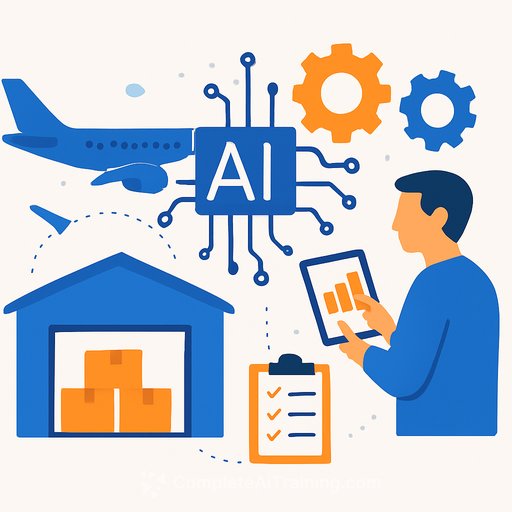AI and Manufacturing: How Operations Leaders Enable Scalable, Autonomous Workflows
Operations teams want one thing: clear, real-time visibility across plants. You cannot get there with manual data pulls and delayed reports. Connected assets and contextualized data remove blind spots and make decisions repeatable and fast.
Break data silos, apply industrial AI, and you move from reacting to directing. The outcome is autonomy at scale-lower costs, higher efficiency, and resilient output without constant human intervention.
What Autonomous Operations Mean
Autonomous operations are "self-governing" systems across the manufacturing lifecycle. They read data, infer what's happening, decide on the next move, and take action-consistently and safely.
These capabilities touch design, manufacturing, supply chain, distribution, direct-to-customer channels, and demand forecasting. The goal is a network of systems that adapt in real time under changing conditions with minimal manual input.
The Industrial AI Maturity Pyramid
Think in levels. Start with connected data and basic visualization. Move into prediction and explanation. Then progress to prescriptive decisions and fully autonomous control.
Each step requires more than software. You will need new skills, better governance, and clear ownership across OT and IT. The payoff grows as you climb: fewer delays, fewer surprises, and tighter control loops.
Asset Monitoring: Find Downtime Root Causes
Asset monitoring is the bridge from pure observation to explanation. Sensor trends, alarms, and maintenance work orders become one story, not three disconnected logs.
With that context, teams isolate root causes faster and compare performance across similar assets and sites. The result: planned work over firefighting, longer asset life, and lower operating cost.
Quality Control: Predict When Issues Will Occur
Quality is where inference starts to pay back fast. Models flag deviations, suggest corrections, and predict when defects are likely. Visual checks and manual sampling give way to automated inspection and targeted interventions.
Monitoring incoming materials further reduces risk. On an electronics line, for example, alerts on potential faults give teams time to adjust before scrap or rework grows.
Adaptive Manufacturing: Adjust Resources Around the Line
Adaptive manufacturing tunes the support system around production in real time. Schedules shift, crews move, and buffers flex based on actual conditions and demand signals.
If a downstream slowdown appears, the system signals upstream to modulate rates. You avoid bottlenecks, smooth flow, and keep WIP under control. This is a practical entry point into autonomous manufacturing.
Predictive Maintenance: Automate the Repair Decision
Predictive maintenance uses historical patterns and live condition data to recommend the right repair at the right time. It reduces unplanned downtime and prevents expensive cascade failures.
Recent progress in edge computing allows models to sit closer to the asset. The most effective programs bring hardware, software, and services under one umbrella, extending classic condition monitoring with smarter prediction and clear action paths.
Process Optimization with MPC: Recognize Variables and Course-Correct
Model Predictive Control (MPC) is a proven path into closed-loop decisioning. It analyzes real-time and forecasted data, manages set points within PLCs, and adjusts parameters within constraints to keep processes stable and efficient.
With MPC, you read from sensors and the PLC-then write back to the PLC to change the line rate or other control variables. That feedback loop sustains optimal performance as conditions shift. Learn more about the method here: Model Predictive Control.
How Operations Leaders Move From Pilots to Scale
- Connect and contextualize data: standardize tags, events, and equipment hierarchies so analytics and alerts are trustworthy.
- Pick use cases with line-of-sight ROI: asset monitoring, quality prediction, predictive maintenance, and MPC are reliable starters.
- Close the OT/IT gap: define ownership for models, PLC changes, patching, and failure response before deployment.
- Build feedback loops: track OEE, MTBF, first-pass yield, maintenance cost per asset, and decision lead time.
- Adopt edge-first where it helps: run inference near the equipment for latency-sensitive control and resilience.
- Manage change: publish playbooks, retrain standard work, and keep operators in the loop with clear explanations of model actions.
- Upskill the team: give engineers, planners, and techs the skills to read models, act on insights, and maintain solutions. For structured options, see AI courses by job.
- Governance and safety: define constraints for automated actions, escalation paths, and audit trails for compliance.
From Data to Autonomous Operations
Real-time visibility and contextualized data set the foundation. Asset monitoring, quality prediction, adaptive support, predictive maintenance, and MPC turn that foundation into action.
As these capabilities mature, systems start handling more decisions on their own-safely and repeatably. That is how operations become scalable, agile, and resilient under pressure.
Your membership also unlocks:






